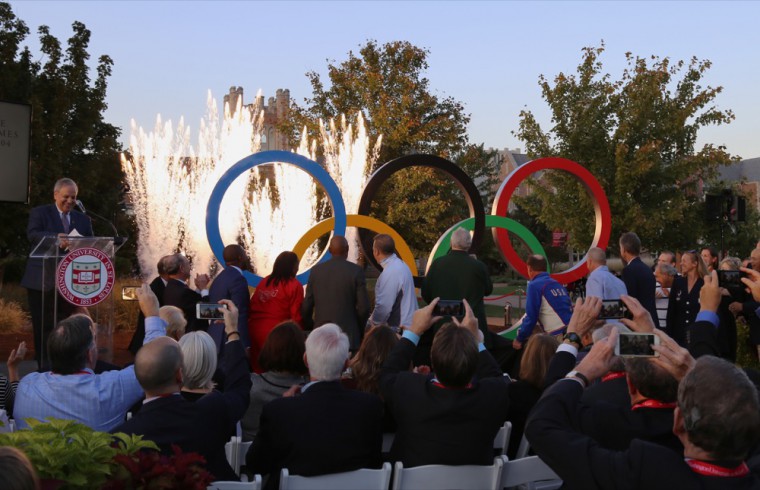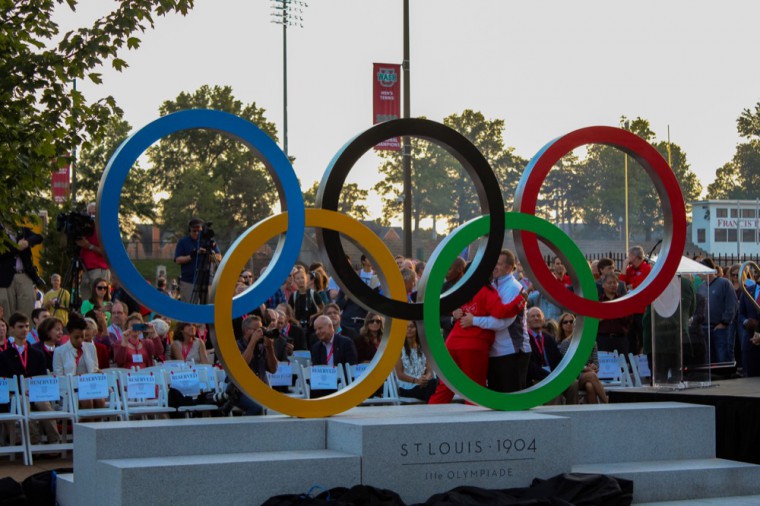Sports
Ringing up the curtain: Inside the decade-long push to display the iconic Olympic symbol
In 2007, St. Louis was 103 years removed from hosting the 1904 Summer Olympics. The first iPhone was released, the final Harry Potter novel debuted and Queen Elizabeth II, born 22 years after the games, became Great Britain’s oldest monarch. So, you could forgive her or anyone else for lacking interest in a 103-year-old event.
That year, James Shadrach Schoenke moved to St. Louis from Atlanta. Friday, he stood front and center as the St. Louis Sports Commission unveiled an Olympic rings “Spectacular” at Washington University, reviving a now-114-year-old legacy. There was no shortage of enthusiasm in the crowd.
 Isabella Neubauer
Isabella Neubauer The Olympic rings sculpture is unveiled to Washington University spectators. The unveiling featured a wide variety of St. Louis-affiliated Olympic athletes and a small pyrotechnics display.
In Atlanta, Schoenke worked for an ad agency whose main client, Coca-Cola, was working on its sponsorship of the 2008 Beijing Olympics. There, a lightbulb went off.
“Just out of Chattanooga, there’s a sign that says, ‘Welcome to Georgia, site of the 1996 Olympics,’” Schoenke said. “You can’t drive through Georgia without knowing they had the Olympics. You can live in St. Louis your whole life and never know we had the first Olympic Games.”
The wheels were turning—spinning in place, but turning nonetheless. Three years later, Schoenke, back in St. Louis permanently, got his wheels greased. Schoenke’s client at Coke landed a job with the U.S. Olympic Committee (USOC). So Schoenke shot his shot: He floated the idea—what if some Olympic signage could be incorporated in St. Louis?
Schoenke’s connection suggested that he send the concept to her colleague at the International Olympic Committee (IOC). At that moment, Schoenke’s thought became possibility, his confidence sinking into uncertainty.
“I had the idea but you sit there and, ‘Should I send? Should I send?’” Schoenke questioned.
Eventually, Schoenke mustered the courage and sent a single page to the Lausanne, Switzerland-based organization. Within a week, he received a response from the USOC’s legal counsel: “What’s your plan? Who’s on board?”
Schoenke, of course, didn’t have a plan, just a brainstorm. That weekend, he was a man on a mission.
“I wrote an 18-page plan,” Schoenke said. “I started calling St. Louis County parks, Wash. U….I was just the guy in a basement trying to call people. Really didn’t have much luck.”
Schoenke’s luck changed quickly because he wouldn’t be alone much longer. In 2011, he reached out to Commission President Frank Viverito, and the inquiry went better than expected. The two met for lunch, discussing Schoenke’s plan and how best to move forward.
Viverito said that Schoenke had “become so enamored with the Olympic movement that he wanted to see it come to life in his hometown.”
The primary roadblock laid in St. Louis’s place among its peers. As one of 43 Olympic hosts, it’s a member of the World Union of Olympic Cities, whose meetings the commission attends annually. However, because the 1904 games predated the five-ringed symbol, St. Louis wasn’t allowed to display it.
But more recently, the landscape changed significantly. The IOC, in part due to St. Louis’s efforts, became receptive to the notion of host cities leveraging their legacies. What that meant for St. Louis was an opportunity to seize its vision.
“We’ve always maintained a relationship with the Olympic movement,” Viverito said. “But the rings themselves became a real possibility to us about two or three years ago when the IOC included it among their objectives that the Olympic cities around the world could create these spectaculars.”
“[The commission] played a big part in the IOC establishing this legacy program, which is [Viverito’s] years of tugging their elbow and networking [his] way through the system,” St. Louis Olympic Committee Chairman Michael Loynd added.
Loynd, an attorney and graduate of the Wash. U. Law School, was the jumpstart. Loynd, introduced by a mutual friend of Viverito’s, joined the movement in 2016. Ironically, his ideas were born out of a similar experience.
“You’d go to some of these small Swiss towns or these small towns around Europe and they’d have Olympic rings out front,” Loynd said. “It was a little village, maybe they had bobsledding there or something like that. You’re like, why doesn’t St. Louis have that?
“Wash. U.’s dear to my heart and St. Louis is dear to my heart, so it got me fired up.”
 Justin Ziegelmueller
Justin Ziegelmueller Spectators celebrate the unveiling of the Olympic rings sculpture next to the site of the 1904 games. The event was attended by Wash. U. students, faculty and the surrounding community.
Now, with Loynd’s own network, the car started racing.
“Michael was a godsend,” Schoenke said. “Where I said, I’m a guy in the basement making phone calls, Michael’s like, ‘Forest Park? Let me call Forest Park.’ All of a sudden, meetings and things are happening, and that coincided with the IOC saying that every city that’s hosted the Olympics is allowed two spectaculars.
“Michael’s on board and opening doors and at that point, that’s when things really started to happen. Wash. U. got on board, [Chancellor Mark] Wrighton tasked a committee: Make this happen.”
“Wrighton immediately got what we were trying to do,” Loynd said. “He got the legacy, he got the history, he got the uniqueness of it that Wash. U. is literally the only university that can say they hosted an Olympics. Nobody gets to say that and it’s so cool!”
Wash. U.’s commitment did waver at one point, Schoenke recalled.
“In the aftermath of Ferguson…Wash. U. realized, we’re kind of an ivory tower,” Schoenke said. “We need to do something more community-engaging…There was a much tighter scrutiny on things that they were willing to focus on.”
Then came the 2017 summit that changed St. Louis’s outlook permanently. At the World Union conference in Montreal, the group had the chance to make their pitch to two members of the IOC who work in legacy development. According to Schoenke, it was the first time St. Louis “had basically our ducks in a row” with a concrete plan. Still, there were speed bumps.
“We are actually the very first city to go through this process,” Schoenke said. “We’re the beta testers…so there was a little bit of a back-and-forth, things aren’t going as quickly as we would like.”
One precondition for the IOC was the assurance that the rings wouldn’t be monetized.
“Because one of the many hats I wear is a foundation, I was able to get a nice upfront gift to really make it happen,” Loynd said. “We’re not going to go to any commercial entities, because the IOC is a little touchy about this.”
After getting approval for two spectaculars, the work began. Three firms primarily worked on the making of the rings—SWT Design, which put together the design, Engraphix, which fabricated the rings, and L.E. Sauer Machine Company, which laser-cut the rings.
Ed Brimer, the president of Engraphix, actually saw a newspaper article about the rings in the spring and pursued the bid through his connections to the University. Brimer felt a strong personal relationship with the project: His father and son both graduated from Wash. U. and Ed married his wife in Graham Chapel.
Engraphix was a natural choice to win the bid given its ongoing relationship with Wash. U.
“They give us a lot of business for the signage and various buildings all over campus,” Brimer said. “This is one more way to tie yourself to a good client and relationship in your own community.”
The rings themselves needed to be able to withstand human and weather abuse while remaining vibrant, so Engraphix used a sustainable approach: stainless steel, paint and an automotive-quality gloss coat finish that holds in sunlight so the color lasts longer without fading. The exact specifications were mostly predetermined by the IOC.
Two of the parameters the commission did have freedom to be creative with were the base and the setting. SWT Design’s Zach Snovelle envisioned the stone podium to pay homage to 1904’s gold, silver, bronze precedent, and the sculpture was an ideal fit adjacent to Francis Field, the games’ stadium, off Olympian Way, a critical point in the famous—and controversial—marathon.
Viverito, for his part, acknowledges 1904’s problems, but warns against evaluating it in a vacuum.
“If we had two cars in the garage, one of them was a 1904 Model A Ford and the other one was a 2020 Lexus, we wouldn’t take a look at the 1904 Model A and say, ‘Oh my gosh, what a junker!’” Viverito said. “We would look at it as such a significant and valuable piece of history, even though it didn’t have the same…steering as the 2020 Lexus.”
As summer progressed and the clock winded down, the construction of the sculpture became delayed—but with some adjustments, Wash. U. was able to avoid another Olin Library situation.
“The original goal was to have it up before the students came back,” Schoenke said. “But we looked at the blueprints of all of the infrastructure, the pipes, the electrical, the sewer lines that’s underneath there. It is a spaghetti bowl right under that area. There are so many things that are happening that we just had to start moving things.”
Finally, the spectacular was unveiled in a ceremony Friday evening, when three-time gold medalist Jackie Joyner-Kersee and other area Olympians helped remove the tarp from the rings to the tune of fireworks.
During the event, Wrighton announced the renaming of Francis Field to Francis Olympic Stadium. Notably, the venue’s namesake remains David R. Francis, who Wrighton says was instrumental in bringing the Olympics and World’s Fair to St. Louis.
“I think reminding people of the important role that a single leader can play is significant,” Wrighton said.
Wrighton also said that bringing the rings to Danforth Campus is about more than simply memorializing its sports history.
“Aspiring to excellence as an Olympian is consistent with our aspiration as a university to be truly outstanding, to win gold medals, if you will, in academics as well as the competitive role that we play in Division III intercollegiate athletics,” Wrighton said.
According to Wrighton, the recognition of St. Louis as a destination is significant for the University and the local community, both as a powerful recruiting tool and as a source of pride.
“When we have prospective students, many—a very large fraction—will take a tour,” Wrighton said. “The Olympic rings will be on the tour and it will be a way to excite interest.
“And when we think about the affirmation that comes from the International Olympic Committee, that alone puts us on the map because important people, obviously from outside St. Louis, had to agree to this.”
The commission continues to work with Forest Park, where 1904’s aquatic events took place, to implement a second spectacular, one that’s “more artistic, more subtle” to match Forest Park’s aesthetic—likely silver and larger given fewer space restrictions.
There are also plans to celebrate the city’s Olympic legacy annually, including an Olympic Day celebration at Wash. U. each June 23, the day the IOC was formed. The event will include Jackie Joyner-Kersee and other area Olympians leading 1,904 kids around the track. Other past and future commission initiatives include bidding for Olympic trials and national world championships, as well as increased signage to help locals and visitors learn about the games.
“Once you have the rings, anything you want to do Olympic-wise or related to the IOC or related to Team USA makes a lot more sense,” Schoenke said. “This will be the first step in a lot of community engagement.”
“This is just the beginning,” Viverito said.
